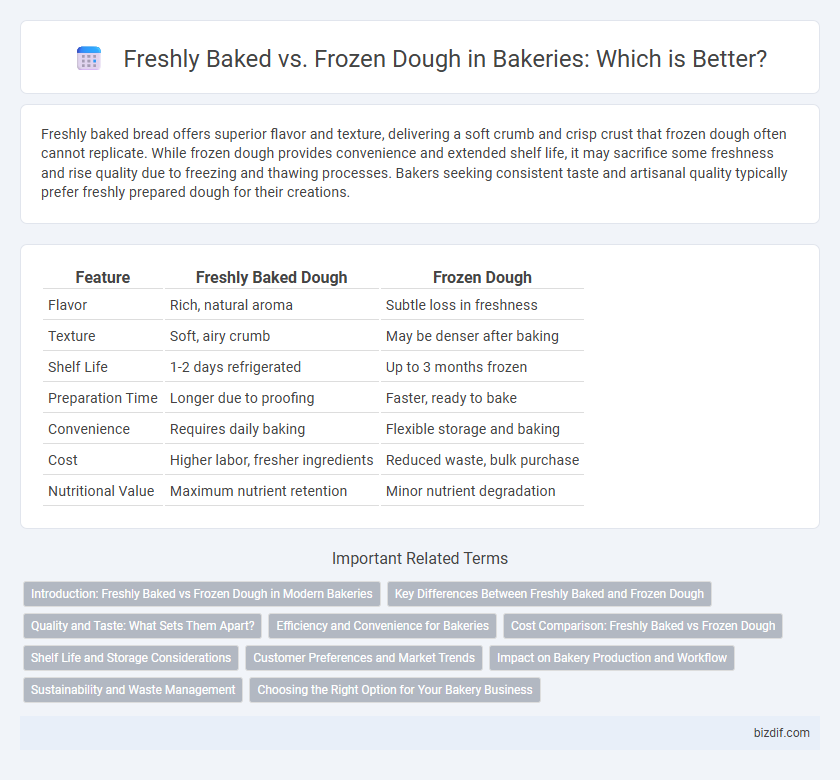Freshly baked bread offers superior flavor and texture, delivering a soft crumb and crisp crust that frozen dough often cannot replicate. While frozen dough provides convenience and extended shelf life, it may sacrifice some freshness and rise quality due to freezing and thawing processes. Bakers seeking consistent taste and artisanal quality typically prefer freshly prepared dough for their creations.
Table of Comparison
| Feature | Freshly Baked Dough | Frozen Dough |
|---|---|---|
| Flavor | Rich, natural aroma | Subtle loss in freshness |
| Texture | Soft, airy crumb | May be denser after baking |
| Shelf Life | 1-2 days refrigerated | Up to 3 months frozen |
| Preparation Time | Longer due to proofing | Faster, ready to bake |
| Convenience | Requires daily baking | Flexible storage and baking |
| Cost | Higher labor, fresher ingredients | Reduced waste, bulk purchase |
| Nutritional Value | Maximum nutrient retention | Minor nutrient degradation |
Introduction: Freshly Baked vs Frozen Dough in Modern Bakeries
Modern bakeries often debate the benefits of freshly baked products versus those made from frozen dough, emphasizing freshness, texture, and convenience. Freshly baked goods offer superior flavor and crumb quality due to immediate baking after dough preparation, while frozen dough provides consistent results and extended shelf life for high-demand production. Innovations in freezing technology now help preserve yeast activity and dough structure, narrowing the quality gap between fresh and frozen options in commercial baking.
Key Differences Between Freshly Baked and Frozen Dough
Freshly baked dough offers superior flavor, texture, and aroma due to the immediate baking process that preserves yeast activity and gluten structure. Frozen dough provides convenience and extended shelf life by halting fermentation, but may result in a slightly diminished rise and softer crust after baking. The choice between freshly baked and frozen dough hinges on balancing freshness and sensory quality with storage efficiency and production flexibility.
Quality and Taste: What Sets Them Apart?
Freshly baked goods offer superior flavor and texture due to the natural fermentation and immediate oven-to-table process, which enhances the aroma and crumb structure. Frozen dough can maintain convenience and extend shelf life, but it often sacrifices subtle taste nuances and moisture levels that are pivotal in bakery quality. Quality in freshly baked products is characterized by a crisp crust and tender crumb, while frozen dough may produce denser textures and less vibrant flavors.
Efficiency and Convenience for Bakeries
Freshly baked dough offers superior flavor and texture but demands longer preparation time and skilled labor, impacting bakery efficiency during peak hours. Frozen dough enhances convenience by allowing bulk preparation and flexible baking schedules, reducing waste and labor costs while maintaining consistent product quality. Bakeries aiming to maximize operational efficiency often balance both methods, using frozen dough for volume and freshly baked for specialty items.
Cost Comparison: Freshly Baked vs Frozen Dough
Freshly baked goods often involve higher labor and ingredient costs due to daily production and immediate sales, whereas frozen dough reduces overhead by enabling bulk preparation and longer shelf life. Frozen dough minimizes waste and storage expenses but may require additional energy for freezing and thawing processes. Overall, frozen dough presents a cost-effective solution for scaling bakery operations without compromising on quality.
Shelf Life and Storage Considerations
Freshly baked bread typically has a shorter shelf life of 2 to 3 days at room temperature, requiring airtight storage to maintain freshness and prevent mold growth. Frozen dough extends shelf life significantly, allowing storage for up to 3 months in a freezer, while maintaining dough quality and flavor when properly thawed and baked. Proper temperature control and packaging are critical for both methods to optimize texture, taste, and safety during storage.
Customer Preferences and Market Trends
Customers increasingly favor freshly baked products for their superior taste, texture, and aroma, driving demand in artisan bakeries and specialty shops. Market trends show a growing preference for fresh ingredients and transparency, with consumers willing to pay higher prices for freshly baked goods compared to frozen dough alternatives. Despite this, frozen dough remains popular in commercial settings due to its convenience, longer shelf life, and consistent quality, catering to high-volume production and cost efficiency.
Impact on Bakery Production and Workflow
Freshly baked dough enhances bakery production by reducing preparation time and ensuring consistent product quality, improving overall workflow efficiency. Frozen dough allows for longer storage and flexibility in scheduling, minimizing waste and enabling bakeries to meet fluctuating demand without compromising freshness. Balancing fresh and frozen dough usage optimizes ingredient management and streamlines operations in high-volume bakery environments.
Sustainability and Waste Management
Freshly baked goods reduce food waste by aligning production with immediate demand, minimizing unsold inventory and packaging waste. Frozen dough extends shelf life, offering flexibility in batch sizes, which can optimize ingredient usage and reduce spoilage. Both methods contribute to sustainability by decreasing landfill contributions and supporting efficient resource management in bakery operations.
Choosing the Right Option for Your Bakery Business
Freshly baked dough offers superior taste, texture, and aroma that enhance customer satisfaction and elevate your bakery's reputation. Frozen dough provides convenience, consistent quality, and extended shelf life, allowing for flexible production schedules and reduced waste. Selecting the right option depends on your bakery's priorities for freshness, volume, and operational efficiency.
Freshly baked vs Frozen dough Infographic

 bizdif.com
bizdif.com